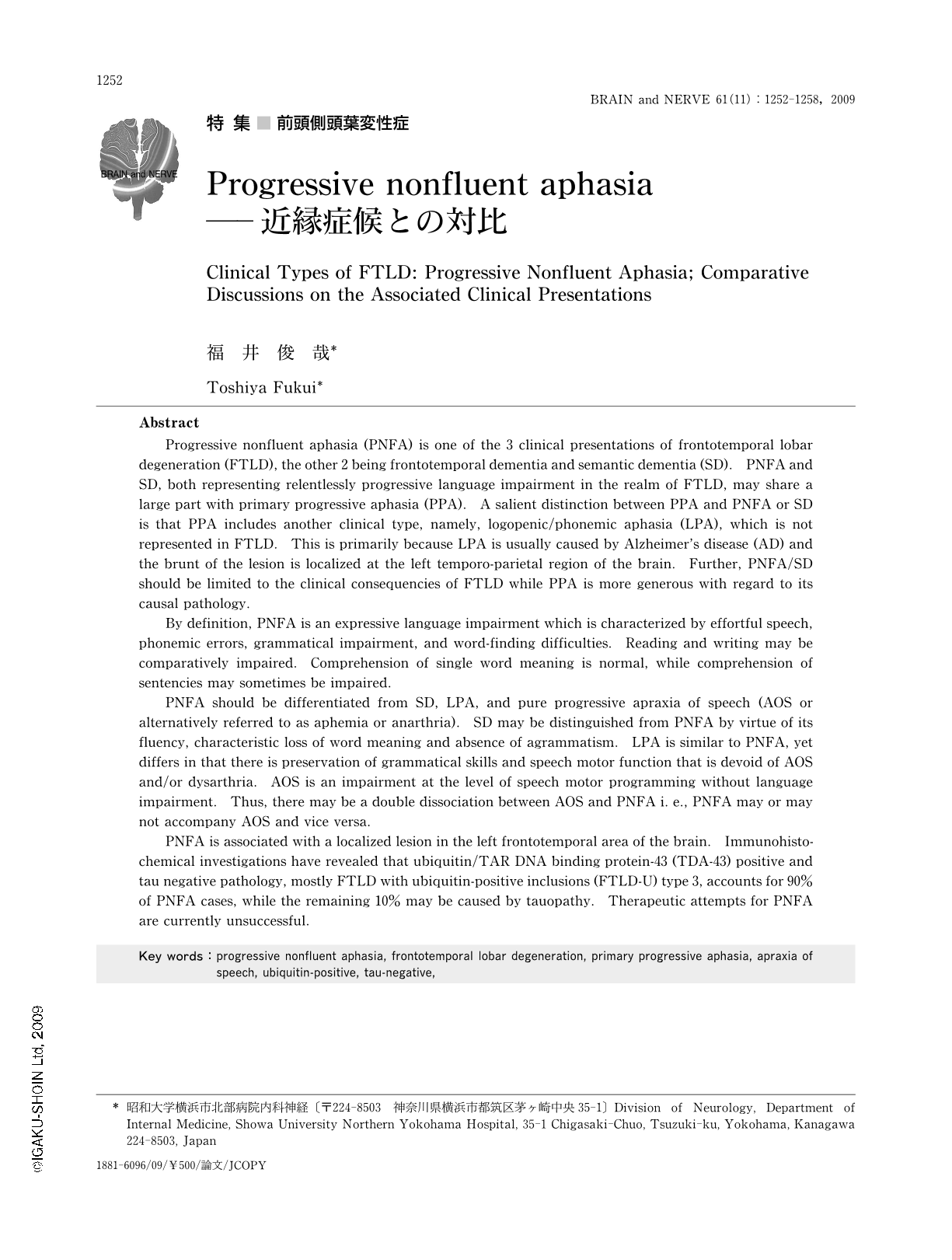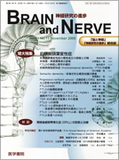Japanese
English
- 有料閲覧
- Abstract 文献概要
- 1ページ目 Look Inside
- 参考文献 Reference
はじめに
最も障害されている認知領域をもって,認知症を特徴づける考え方がある。言うまでもなく,記憶が一義的に障害される疾患がAlzheimer病(Alzheimer disease:AD)であり,人格・行動・感情が一義的に障害される疾患が前頭側頭型認知症(frontotemporal dementia:FTD)である。同様に,主に言語系が一義的に障害される疾患が進行性失語である。
進行性失語の概念は,北米では原発性進行性失語(primary progressive aphasia:PPA)として1980年初頭に提唱された。この概念は純粋に臨床症状に立脚したものであり,その後,広く受け入れられ汎用されている1,2)。一方,Arnold Pickの思想の影響が強い欧州では,Pickが側頭葉の限局性萎縮と進行性失語を関連付けたことから,進行性失語は前頭側頭葉の限局性萎縮を呈する疾患〔前頭側頭葉変性症(frontotemporal lobar degeneration:FTDL)〕3)の一臨床症状である点を重視する。
Abstract
Progressive nonfluent aphasia (PNFA) is one of the 3 clinical presentations of frontotemporal lobar degeneration (FTLD), the other 2 being frontotemporal dementia and semantic dementia (SD). PNFA and SD, both representing relentlessly progressive language impairment in the realm of FTLD, may share a large part with primary progressive aphasia (PPA). A salient distinction between PPA and PNFA or SD is that PPA includes another clinical type, namely, logopenic/phonemic aphasia (LPA), which is not represented in FTLD. This is primarily because LPA is usually caused by Alzheimer's disease (AD) and the brunt of the lesion is localized at the left temporo-parietal region of the brain. Further, PNFA/SD should be limited to the clinical consequencies of FTLD while PPA is more generous with regard to its causal pathology.
By definition, PNFA is an expressive language impairment which is characterized by effortful speech, phonemic errors, grammatical impairment, and word-finding difficulties. Reading and writing may be comparatively impaired. Comprehension of single word meaning is normal, while comprehension of sentencies may sometimes be impaired.
PNFA should be differentiated from SD, LPA, and pure progressive apraxia of speech (AOS or alternatively referred to as aphemia or anarthria). SD may be distinguished from PNFA by virtue of its fluency, characteristic loss of word meaning and absence of agrammatism. LPA is similar to PNFA, yet differs in that there is preservation of grammatical skills and speech motor function that is devoid of AOS and/or dysarthria. AOS is an impairment at the level of speech motor programming without language impairment. Thus, there may be a double dissociation between AOS and PNFA i. e., PNFA may or may not accompany AOS and vice versa.
PNFA is associated with a localized lesion in the left frontotemporal area of the brain. Immunohistochemical investigations have revealed that ubiquitin/TAR DNA binding protein-43 (TDA-43) positive and tau negative pathology, mostly FTLD with ubiquitin-positive inclusions (FTLD-U) type 3, accounts for 90% of PNFA cases, while the remaining 10% may be caused by tauopathy. Therapeutic attempts for PNFA are currently unsuccessful.

Copyright © 2009, Igaku-Shoin Ltd. All rights reserved.


